
I’m not a gunsmith, so when I decided to create my own AR-15 build kit I knew there would be a learning curve and, possibly, some flying springs.
In fact, that’s what happened the first time I tried a DIY Milspec trigger assembly. I ordered the trigger components from Bushmaster, back when Bushmaster was still in Windham, Maine and before it was bought out by Remington. (The original Bushmaster team later founded Windham Weaponry). Without the right tools for the job, no experience, and no one other than a book to guide me – *SPROING* went one of the springs.
I eventually found it after scouring the floor – bent beyond repair.
I called Bushmaster, told them of my woes, and ordered a few replacement springs. The sales rep, upon hearing my mailing address, said he lived nearby and he could just meet me that weekend to do it for me. I let him assemble the entire fire control group and I never messed with it again.
About 20 years later I was ready to give it another attempt, albeit guided by my friend and fellow SHTF Blog writer, Drew Forge, who has far more experience with the guts of an AR-15 than I do. He assisted writing this article, so there might be multiple writing voices and points of view within the article.
Why a DIY AR-15 Build Kit
I’ve shot enough different AR-15s over the years that I wanted something that I could truly call my own, something that was built to my specifications from buttstock to flash hider. There are plenty of off-the-shelf AR-15s available for purchase with a wide variety of configurations, but I wanted my own.
The advantages of putting together my own AR-15 build kit seemed clear:
- I could get the exact AR-15 configuration I wanted.
- I could save money by buying only the pieces I wanted, not having to spend extra to swap out components for parts I wanted to upgrade.
- I could learn a bit along the way by “building” the AR myself.
There are various AR build kits available on the market for the aspiring AR gunsmith, but the problem I found is that they’re still “standard” builds. I was not interested in buying a build kit that only included a set assortment of components. I wanted to pick my own parts, and build an AR with those. This is what I mean by a “DIY” build kit.
Recognizing my gunsmithing limitations, I also wanted to be realistic about how deep into a build I was willing to go. I wanted something manageable for a first build. My middle ground in this DIY build was deciding to build the lower receiver myself and buying an assembled upper assembly. This decision was made easier by the fact I found an entire upper assembly that was configured exactly how I wanted, the Primary Weapons Systems MK116 PRO. I wanted a higher-end build and it made sense to splurge for my dream upper. This was it.
You don’t need to buy or build an upper as fancy as this one in your DIY AR-15 build kit, so we’ll walk you through choices to make sure you are picking and choosing the parts that create the rifle you desire.
Why Optics Planet
There are countless online and brick and mortar stores where you can buy complete ARs and AR-15 parts. It wouldn’t take much to buy each part of an AR from a different store, or different manufacturer for that matter. For ease of shopping, I went with a store that I’ve used plenty of times before – Optics Planet.
With a few exceptions, mentioned below, I used their site to buy everything in this build. The prices were competitive and everything came together at once (except when I realized I missed a few pieces and needed to place a second order). Besides that, we’d done a build with Palmetto State Armory before and it was time to change it up.
Optics Planet doesn’t make their own brand of firearms like PSA, which allowed me to easily pick between different manufacturers to assemble all of the pieces I wanted from one online retailer.
Easy!
Necessary Tools
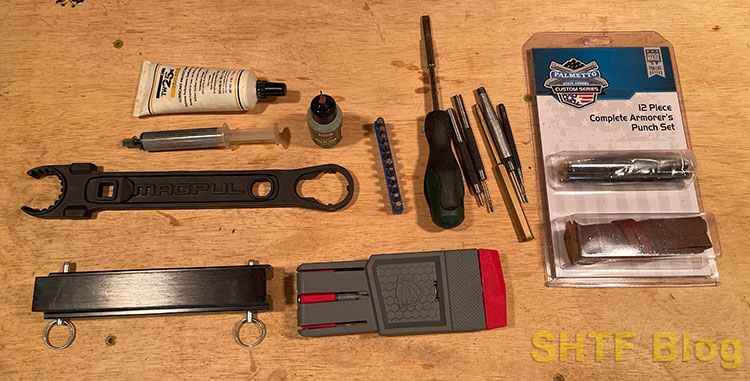
- Rubber mallet and Ball Peen Hammer
- Magpul Armorer’s Wrench (a Godsend when assembling ARs) or similar tool
- A set of Allen wrenches – 3/16″ for attaching the grip, 1/8″ and 1/16″ for various accessories)
- A dedicated set of punches – look for a set with roll pin starter punches, it’ll pay for itself in no time through lack of frustration and scratches on your receivers! This Wheeler set is excellent.
- Brass Drift
- Magazine well lower Vice Block like the shown Real Avid Lower Vice Block
- Upper receiver Vice Block – excellent for changing muzzle devices, gas tubes, and handguards, even if you order fully assembled upper receivers
- Grease and oil – I like Miltech TW-25B and Ballistol or Hoppes Elite, but there are tons of great options out there!
- A torque wrench that measures in ft-lbs – used for castle and barrel nuts and muzzle devices
- Masking tape or business cards to guard your receivers when driving roll pins (especially the bolt release pin)
- Not shown, but HIGHLY recommended: Front pivot pin detent assembly tool
Upper Receiver Assembly Systems
There are so many great options already available, something to fit virtually every need and use. This is what I found, so assembling an upper wasn’t entirely necessary. When shopping for your AR – especially if you’re going component by component, here are some things to consider.
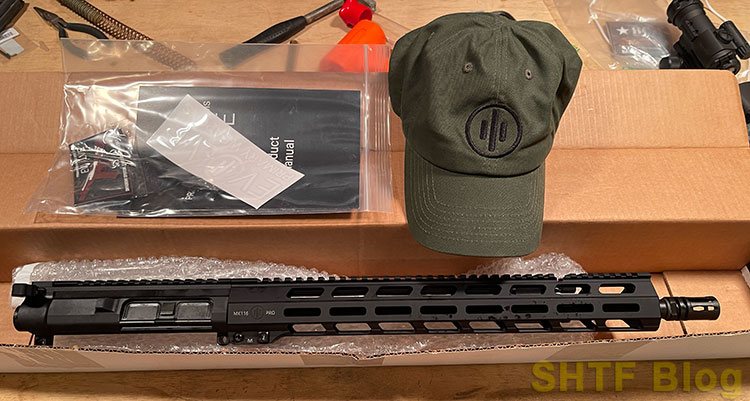
Barrel Specifications
Lengths
Barrels are a deep, deep rabbit hole to get into. We’re focusing on the 5.56/.223/.223 Wylde caliber for this build. However, depending on whether you want to build an AR pistol, standard carbine, Government model/A2 AR, or a precision rifle, you can get barrels in lengths starting at a crowd-pleasing fireball-inducing 5 inches(!) all the way out to 24 inches for the target and varmint pattern barrels.
Most AR carbine builds these days have barrels in the 14.5 inch to 16 inch range. Remember, if you get a 14.5 inch long barrel you need to get a muzzle device that is at least 1.5 inches long so it makes the complete barrel assembly 16″ or longer. Your muzzle device must be pinned and welded as well to comply with ATF guidelines.
Twist Rates
Many people needlessly complicate the rate of twist debate for a 5.56 AR. Common rates of twist (ROT) are 1:7, 1:8, and 1:9. Some older rifles and modern light-bullet varmint builds might be spotted with 1:10 or 1:12 ROTs; 99% of the people building ARs (including me) will do very well with the 1:8 rate of twist. It’s a great all-around compromise, shooting 55 grain and 62 grain military surplus ammo well, as well as heavier 69 and 75+ grain tactical or precision loads.
If you’re shooting the lighter 55 and 62 grain bullets exclusively, there’s nothing wrong with a 1:9 ROT barrel – but you may mind accuracy lacking if you decide to run heavy bullets loads through your gun. The converse is true for 1:7 twist barrels – the faster rate of twist (1 revolution in 7 inches) will stabilize longer, heavier bullets – but may over-stabilize lighter projectiles and cause accuracy issues with 55s and 62s.
Long story short: know the ammo you’ll be using and get the proper ROT if you’re chasing the best accuracy you can wring from your rifle. That being said, almost all modern AR-15s in 5.56/.223 Wylde are running 1:8 or 1:7 twist barrels. If you don’t want to overcomplicate things, get a 1:8 and don’t look back – that’s what I did with this build; my .223 Wylde barrel sports a 1:8 twist for versatility.
Profiles
Barrel profiles are a balancing act: weight vs. rigidity vs. heat dissipation. A skinny, lightweight barrel will be a joy to carry and handle, but it will heat up very rapidly and has the potential for groups to open up or suffer zero wander. A heavier, longer barrel offers increased rigidity and larger surface area for cooling, but they’re sometimes oppressively heavy.
Every barrel profile was designed with a purpose; put some mind science into what you want your AR to be used for and buy appropriately. M4-pattern barrels seem to offer a good compromise in weight and rigidity; (plus a stepped notch to mount your M203 – har har!) it’s a good place to start your search.
Gas System
There are two main types of gas systems that make an AR function: the classic (and standard) Direct Impingement (DI) gas system, and the gas piston driven system. There are a million words already written on DI vs Piston AR operating system, so we’ll distill the generally accepted pros and cons of each down.
Direct Impingement systems are common, lightweight, inexpensive, relatively more accurate due to less moving parts putting strains on the barrel and fiddling with its harmonics, and they generally generate less felt recoil due to lower mass of reciprocating parts. However, DI guns tend to get dirtier much more quickly, they are more difficult to adjust the gassing rate (important for you suppressor guys) and can be prone to gas port erosion over the course of many rounds.
Gas Piston guns are considered to be more reliable and less ammo-sensitive than DI guns, and they run cooler and much cleaner than DI, since there is a physical operating rod doing the operation work of the rifle, instead of hot gasses. But the downsides of Gas Piston ARs are increased cost, lower probability of replacement parts compatibility post SHTF, and increased felt recoil.
I decided to run a PWI gas piston system on this AR for increased reliability and because I wanted a build that was higher-end.
Bolt Assembly
There are varying opinions on what comprises the best bolt for an AR system. If your rifle didn’t come with a bolt and you need to source one from the aftermarket, always buy the best bolt you can afford; it’s the life of your rifle and therefore, by the transitive property, possibly the life of you when the balloon goes up.
Our PWI upper receiver was a gas piston operating system, and it runs on a proprietary PWI two-piece bolt-and-operating-rod system – so we didn’t have much choice here. We need to run this particular bolt.
However, if you’re running a DI gun, the material, finish, and design choices are staggering. I like to run a “full auto” bolt for the little bit of extra weight and potentially better cycling; coincidentally, most bolts you’ll source these days are standardized in the full auto configuration (it’s not illegal to own a “full auto” bolt, FYI). Shot-peened and pressure tested or magnetic particle inspected bolts are worth the few extra bucks to ensure your bolt’s material is free of stress fracture points or other issues. High-lubricity coatings that reduce friction and wear aren’t a terrible idea either.
Whatever you end up purchasing, ALWAYS check to ensure the gas key is properly mounted on the bolt (you shouldn’t be able to see even the faintest sliver of daylight between the key and carrier) and that the key’s mounting screws are securely staked. Also, popping the extractor out of the bolt itself and making sure the spring has the “extra power” rubber O-ring around it is excellent insurance to keep your extractor running reliably.
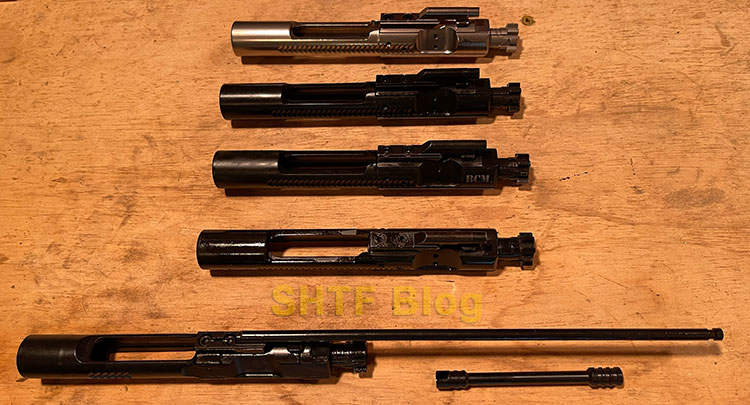
Remember, AR’s generally like running “wet” or well-lubed. Be sure to juice that bolt up before you assemble it into the rifle!
Charging Handle
There are three general types of standard charging handles you’ll see on ARs (we’re excluding the funky side-charging handles): standard or mil-spec, extended latch, and ambidextrous. The standard charging handle is simple and works okay, but doesn’t offer you much increased leverage to operate the gun under less-than-optimal conditions, and you need to wrap both fingers on the charging handle to charge the gun.
Extended Latch charging handles take the small latch offered on standard charging handles but replace it with a larger system that projects out slightly further on the left side of the rifle. This provides far superior leverage and capability to run the gun by allowing the operator to keep his firing hand in place, but use the support hand to more easily charge the rifle or clear malfunctions, even with the rifle on or near the shoulder.
Ambidextrous charging handles offer the same benefits as the extended latch system, but offer latches on both sides of the charging handle, increasing the versatility and function of the rifle for southpaws or perhaps injured operators.
Handguard
The handguard(s) on an AR are possibly the most mission important part of the build; the days of those obsolete two-piece ribbed A2-style handguards are OVER – let’s step into the 21st century with a modern setup, shall we?
The handguard provides a mounting point for most of your accessories – front sight, sling, lights, fore grips, bipods, lasers…the list goes on. You’ll run into two types of handguards generally; the free-float system, and the two-piece drop-in types that you’ll use after you throw your ribbed-for-nobody’s-pleasure A2 handguards in the forgotten parts bin.
The drop-in types are dominated by the Magpul MOE lineup, and for good reason. These tough, well thought out, modular handguards are effective, inexpensive for what they offer, provide multiple points for the universe of MLOK attachments, and they come it lots of spiffy colors. The drop-in systems clamshell over the barrel in two halves, and utilize the Delta ring in front of the receiver to clamp the halves in place.
You order yours for the length of your barrel/gas system (carbine/mid-length/rifle) and go from there. For utter simplicity, modularity, and wallet friendliness, you can’t beat the Magpul MOE. Really.
Free-float handguards (so named because they attach at the rear and float freely over the barrel without touching it) come in a dizzying array of designs, materials, lengths, and attachment points/methods; too many to go into in detail here. Go for the one you like (and can afford) that offers the end results you need. Here is how to install one.
Pretty standard for a 16″ carbine is a 13 or 15″ rail setup; we have the latter length on our PWI upper. Where this rifle is a piston gun and has a slot to adjust the gas port, we were happy that the handguard the upper came with fit our needs, being 15″ long and MLOK compatible.
About that “MLOK” – you’ll run into three standard types of mounting systems (a few companies like Troy have some outliers but you don’t see them too often): Keymod, MLOK, and integral picatinny rails. MLOK is generally becoming the industry standard attachment system , though the other two systems work just fine. Whatever you get, make sure that any accessories you boy are appropriate for your handguard’s attachment method.
Optics
Ahh, optics. The great versatility of the AR platform is accentuated by the top-mounted picatinny rail system included on almost all modern AR platform rifles and pistols. Knowing how to use iron sights (and buying quality back-up irons like the Magpul MBUS PRO sights you’ll see on a few of the pictured rifles in this article) should always be step on on learning how to use a rifle effectively – but a quality optic is certainly a force multiplier that can enhance your skills and make sighting faster and more precise.
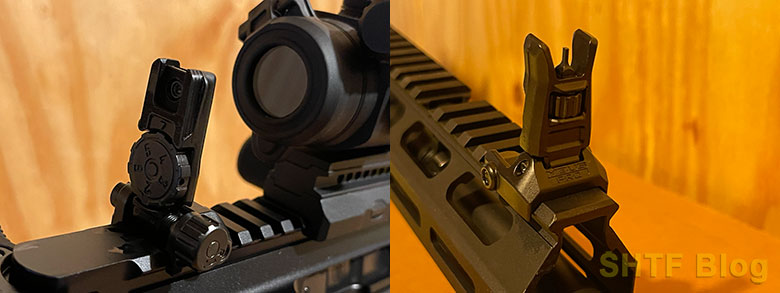
Optics come in a few standard flavors – we’ll cover the three most popular.
Red Dots
Red dot and reflex type sights project a small red dot onto a lens that is a very simple aiming point. There are no eye relief issues, meaning you can put the optic as close to or as far from your eyes as you wish. They do run on batteries, but modern red dots – especially those from Swedish company Aimpoint – offer years of battery life from a single battery.
Rheostats on the optic body allow the user to adjust dot brightness to compensate for ambient light conditions. Red dots are traditionally non-magnified, and their dots cover up a portion of your target that increases the further away your target is. For this reason, red dots usually aren’t the choice for long-range precision work, but are instead superb choices for fast, close-in work.
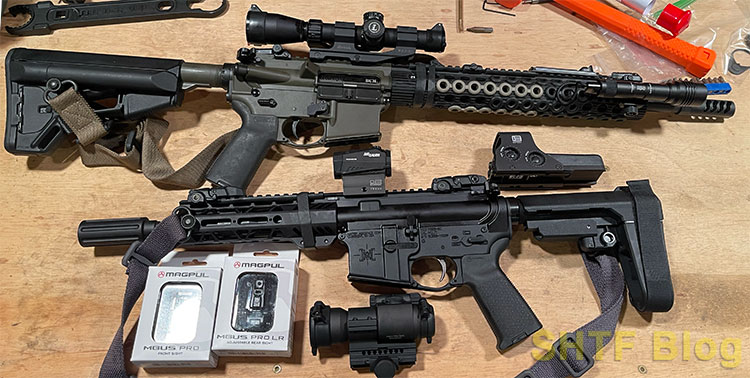
Holographic Sights
Holographic sights like the ubiquitous Eotech family of optics, or the Vortex AMG UH-1 work by using a laser diode and a series of reflectors inside the housing of the optic to create a reticle in the viewing port of the sight, much like a heads-up display on a modern fighter jet. Because of this system, the holographic sight has no parallax issues and the reticle is always shown in the middle of the optic’s wide field of view.
Like red dots, holographic sights are incredibly quick to use and can offer multiple aiming points in the reticle – Vortex’s excellent USB rechargeable AMG UH-1 holographic sight offers a circle-and-dot reticle, along with a triangle in the 6 o’clock region of the reticle that offers a secondary aiming point that takes into account the offset in the sights and bore axis on ARs for up-close-and personal work.
However, holographic sights can be thirsty and there’s a possibility chew through batteries frequently; whereas a good red dot sight can offer 50,000 hours of continuous-on, a holographic sight might offer one hundredth of that battery life. It’s a big difference to consider when stockpiling batteries for post-SHTF caches.
A side note while we’re considering optics for SHTF ARs: red dots and holographic sights have batteries and circuitry that would likely be susceptible to damage in an EMP event. If you’re looking for an upgrade over iron sights that would be EMP proof, read on!
Magnified Optics
LVPO (Low Power Variable Optics) sights are incredibly popular on AR platforms, as they offer precise aiming reticles, they do not require batteries, and with a quick rotation of a collar on the body of the scope, you can change the magnification level seen through the optic. Most LVPOs you’ll run into are generally in the 1x-4x (meaning it can magnify the field of view in the optic from 1x, or no magnification, to 4x, 4 times the magnification) or 1x-6x range, with some outliers out there that go higher. Precision AR-15 builds can run optics at 20x magnification and beyond, depending on your needs and bank account enthusiasm.
The green AR in the picture above sports an older Leupold MK AR MOD 1 on a Burris PEPR mount- an excellent, high quality setup that has stood up to many range sessions, coyote hunts, and training courses. The low power 1.5x-4x magnification is easy to use in close quarters situations at its lowest setting, but the highest 4x magnification is useful for engaging targets at 200 yards and beyond even. This one has a 1″ diameter tube, but if I was doing it over I’d probably look for a 30mm tube LVPO for more light transmission into the optic.
Many companies make dynamite LVPOs – Leupold, Vortex, Trijicon, SIG Sauer, Burris, and others – just be sure to plunk some serious money down on a high quality brand name optic and a high quality mount – a cheap scope will absolutely ruin your day as soon as you let it.
An interesting hybrid to note is Leupold’s “Firedot” scopes (there are probably other manufacturers that offer similar products, but to be honest, I don’t stray too far from Leupold) – yes, they are battery powered, but they combine the usefulness of a LVPO with a red dot, transposing a glowing dot on the center on the optic.
You can turn the dot off to conserve battery life and use the optic as a regular magnified scope, or you can turn the dot on to enjoy the fast close-in reference of a dot sight. When the battery dies, you still have the utility of the standard reticle to boot – another thing to consider for a SHTF scenario.
Lower Receiver Assembly Systems
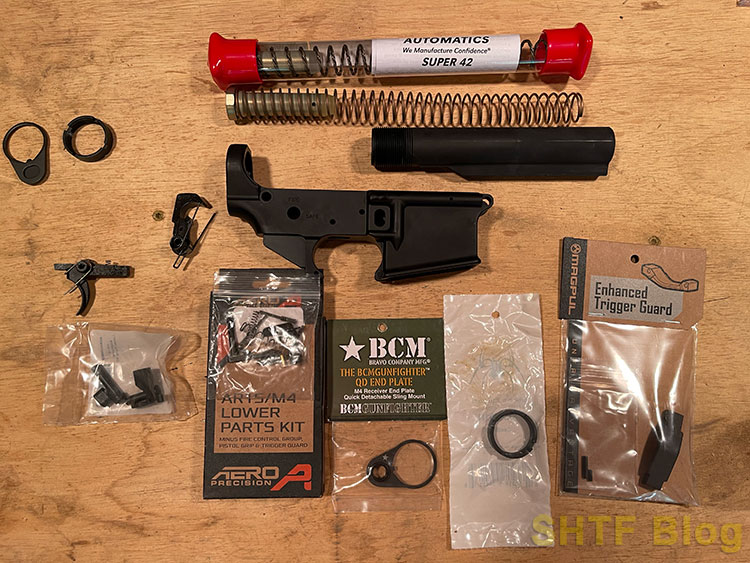
Buffer and Receiver Extension/Buffer Tube
The buffer and spring that ride inside of the receiver extension (commonly called the “buffer tube”) should be matched to your caliber, gas system length, and intended use; a standard 5.56 mid-length gas system will usually need a different buffer weight than, say, a suppressed .300 Blackout pistol.
For this build, an H2 buffer weight was utilized as it is a pretty standard weight for a mid-length AR carbine; the PWI upper has an adjustable gas block so we can dial the system in as needed in case the buffer weight is a bit off and recoil is high or the rifle doesn’t function properly or if we wanna run with a can. Those of you building DI guns would likely have to fiddle with buffer weights as an introductory step if you’re running into cycling issues.
Fire Control Group
The Fire Control Group (or FCG) is comprised of several standard parts on an AR-15: the hammer, the trigger, the disconnector, the disconnector spring, the hammer spring, trigger spring, and the two pins that hold the whole works in the receiver. You can go one of two ways: a “DIY” mil-spec FCG assembly where you must assemble all the parts inside the receiver, or a one-unit drop-in trigger assembly that is a bit more refined and easier to install.
If your Lower Parks Kit doesn’t come with an FCG, you have more homework to do and another purchase to make.
Mil-Spec DIY FCG Assembly
You can, with relative ease and a few extra springs just in case, assemble a basic trigger assembly from purchased parts. We’ll get into the installation methods shortly, but let’s look into why you might buy a mil-spec FGC over a usually superior drop-in trigger for your AR platform rifle.
First off: Cost. A good drop in setup can run into the hundreds of dollars; a decent-quality FCG from, say, Aero Precision might run you $50.00 and provide a functional trigger pull. However, you can buy a super pricey high-end FCG like the Geiselle SSA-E for over $200.
Parts compatibility and functionality down the road or post SHTF is another aspect to look at when selecting an FCG type. A drop in trigger will likely be comprised of a mostly sealed unit stuffed full of proprietary parts; a mil-spec trigger assembly is just that: standardized parts built to a specification.
If you need to fix a broken or worn FCG part on your AR, a local gun shop is almost certainly going to have mil-spec parts on the shelf for cheap; not so much for your super drop-in trigger. Also, after the balloon goes up and you have to scab parts to keep your beloved custom built rifle running, mil-spec parts are going to be a lot more readily available in theory.
Customization is something to remember as well; remember, you can do your own trigger job on the cheap if you’re working on a low-budget build. Just remember: a cheap FCG, while entirely functional, will net you a gritty, heavy trigger pull that can impede fine accuracy. Spending a few extra bucks on a name brand FCG will give you a far superior trigger pull from the start.
Drop In Trigger Assembly
The drop-in trigger assembly is easy to install. It, quite literally, just drops in. Drop it into the Fire Control Group cavity on the lower receiver, and align the holes to set the trigger and hammer pins. Run a drop of oil on the pins, press or tap the pins lightly in with a mallet. It’s about as easy an upgrade as it gets in the AR-15 world!
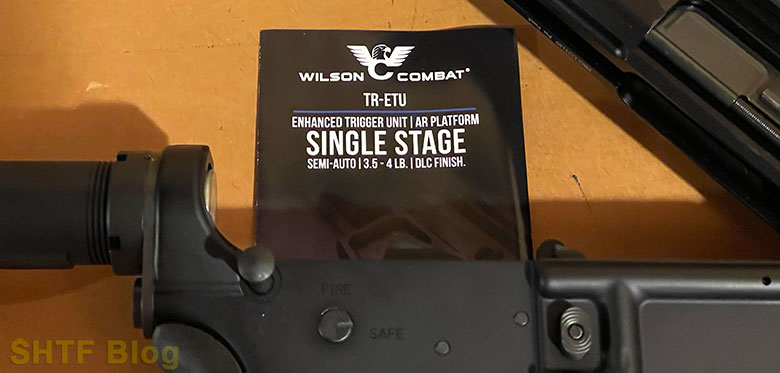
We used a Wilson Combat Tactical Kit single stage trigger and it is absolutely SUPERB, with a crisp 4 lb. trigger pull. Many other companies like CMC and Timney make outstanding adjustable drop-in trigger sets, but this Wilson Combat unit is among the best we’ve personally tried.
Grip
A grip is an entirely personal selection, based on material, texture, contours, and storage capacity. I’ve recently been turned onto the TANDEMKROSS Hive Grip and I love them, but for most people, the first and final word is Magpul. The MOE grip is the standard against which all others are judged, and with excellent ergonomics, swappable storage units, and a few different configurations, it’s not hard to understand why.
We took a poll here at SHTFblog, and we like the rubberized MOE-Plus Grip best. Don’t put those old skinny A2 grips on your SHTF AR; yeah they’re nostalgic but they just kind of… suck functionally. Unless you don’t like storage and you enjoy getting your fingers roughed up by the underside of the receiver’s trigger guard ears – you do you.
Stock
The pièce de résistance for your AR lower is the stock. Simply replaced, the stock is one of the first upgrades AR owners make over the old M4 style collapsible stock – a design that dates back with very few changes to the CAR-15 of the Vietnam era! There are lots of killer options out there (like anything else in the AR world) but the Magpul CTR stock is where you should start your search. Simple, rigged, lightweight, and with several sling attachment options (including integral QD sling ports), the CTR is a great first stop on your way to AR greatness.
In the picture below, the upper AR-15 has a Magpul ACS stock, replete with side storage compartments for batteries that double as cheekwelds, and an extra storage compartment in the butt itself. While heavier and not cheap ($90.20 at Optics Planet at the time of this writing), the ACS is a superb tool to accentuate a self-sufficient out-the-door AR-15 – load it up with spare parts and a small punch and some CR-123 batteries, and your AR is ready to go!
However, for our subject build AR, we elected to run the cleaner, less obtrusive Magpul CTR stock. Be sure you check your buffer tube for milspec versus commercial when ordering! Make sure you buy the correct stock for your buffer tube; though Milspec is now industry standard, manufacturers still offer commercial buffer tubes and stocks.
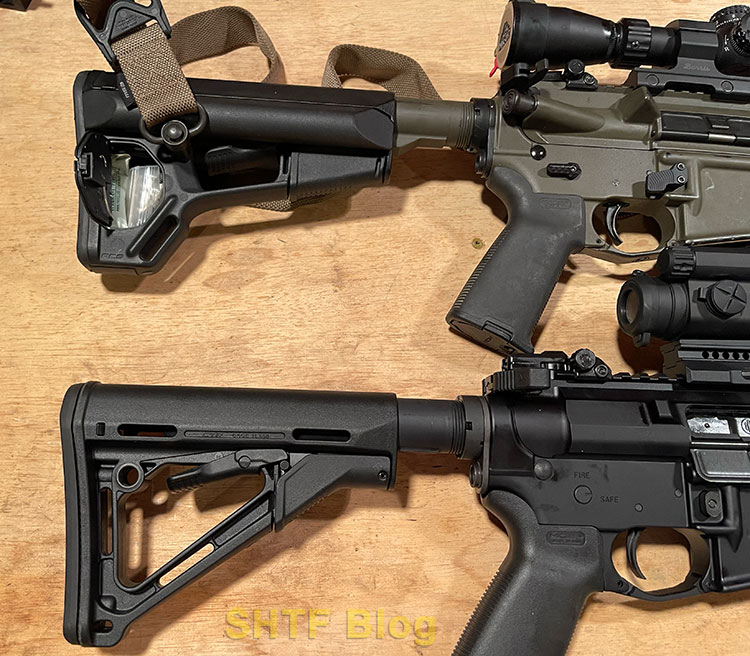
Assembling Your Lower Receiver
Helpful Hint: Keep all pieces together and organized. After pulling kits out of their shipping bags so we could get an accurate piece count, we set all small parts in a Ziploc bag while working so they could not get lost before they were installed.
There are a bazillion books and YouTube videos out there, but we like Optics Planet’s excellent AR-15 How-To Assembly series, which you can find here. We’ll touch on the steps but for a more in-depth video, we definitely recommend the Optics Planet page.
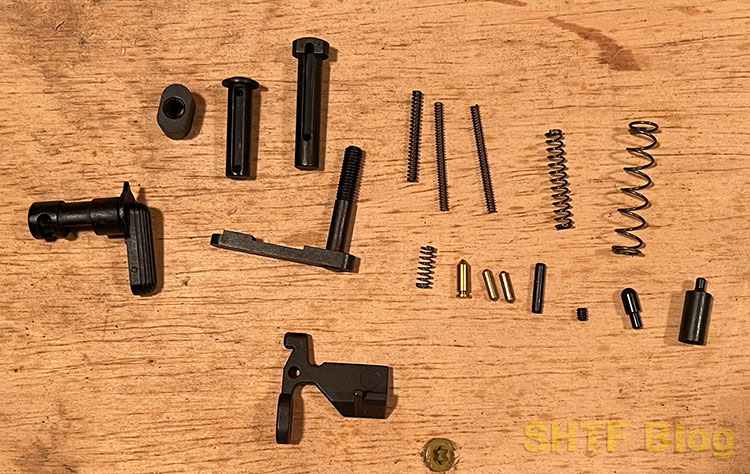
Parts needed: Base Lower Parts Kit, Additional Lower Parts Kit, Trigger, and Trigger Guard. These parts can be purchased in different packages or all-in-one Lower Parks Kits, or LPKs. Please note that some manufacturers offer LPKs with and without the Fire Control Group (FCG), which comprise the hammer, trigger, disconnector, and associated springs
Pro tip: if this is your first time assembling an AR stripped lower, do yourself a favor and order a few extra detents and springs. You’ll need them after you send a couple into lower Earth orbit. Even if you got the pivot pin assembly tool, the extra detents and springs are highly recommended.
Stripped Lower Assembly Steps
1) To assemble the bolt catch, first drop in the spring, then the plunger into the recess on the left side of the receiver. I’ll usually set a drop of oil on the rounded dome of the plunger.
2) Insert plunger roll pin (right to left), and using a piece of cardboard to protect the receiver, and use a mallet and nail punch (brass is preferred as it’s softer and less likely to mark the receiver) to gently tap it in. I’ll usually start the roll pin before putting the bolt catch in its slot so I’m not juggling keeping a bunch of parts aligned – but be careful not to drive the roll pin so par that it protrudes into the bolt catch slot!
Once the roll pin is started and stable, insert the bolt catch, press it against the plunger spring tension, and drive the roll pin home, taking care to ensure it goes through the pin hole on the bolt catch. Seat the roll pin flush.
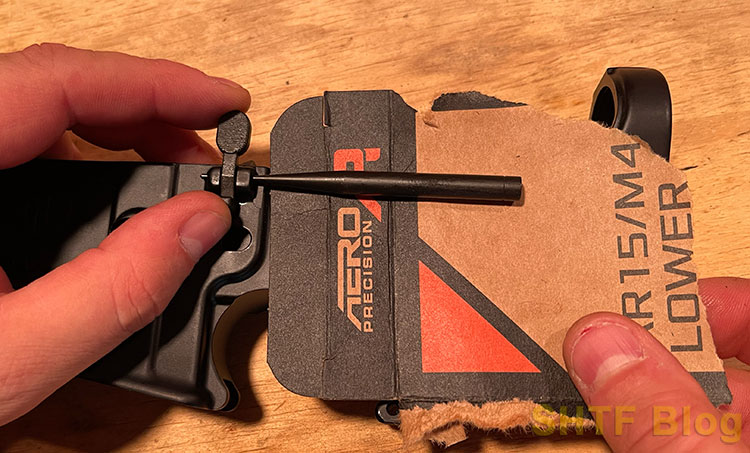
3) Insert the magazine release into the left side of the receiver, and drop the magazine release spring (it’s the largest spring in the LPK) onto the opposite end around the threaded shaft of magazine release; again, I like to put a drop of oil on the threads.
4) Set your magazine release button on the threaded shaft, press down and spin it on. It will be under spring tension. You will reach a point where the magazine release button cannot be screwed on any further; at this point, align the button’s orientation with the hole on the right side of the receiver, push the button as deep into the receiver as you can. and the magazine catch will protrude out the other side. Pull the catch away from the receiver and turn it clockwise until the threaded shaft protrudes into the button and sits just below flush on the surface of the mag release button. Take care not to scratch your receiver as you turn! Test it with an unloaded magazine to make sure it seats and releases properly.

5) Insert your trigger guard in the correct direction (the threaded end goes toward the front, or magazine well, of the receiver). Find the tiny machine screw and wind it in with a 1/16″ Allen wrench. Take the trigger guard roll pin and align the rear of the guard with the holes and use the roll pin starter punch to get it in position and finish with a mallet and punch. Make sure the underside of the rear trigger guard tangs are supported!! Use the edge of a work bench or block of wood. Otherwise you risk breaking the receiver.
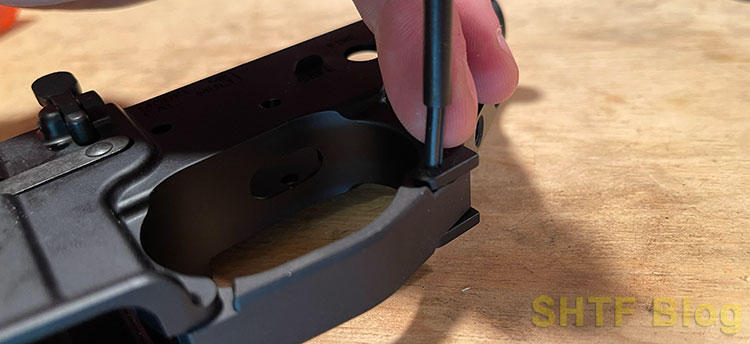
6) Time to put the lower bench block in a vise (optional but recommended) and the lower receiver securely on the block for the front takedown pin assembly (also referred to as the pivot pin). Note that in your LPK you have two identical long, skinny springs and two identical small brass detents. You’ll need one of each for this step.
Insert the spring into the hole on the front of the receiver, above and forward of the magwell on the right side. the detent sits on top of the spring, in the hole. If you didn’t get the assembly tool, you can use a single edge razor blade to push the detent in and hold it flush as you push the front takedown pin in place from the right. A pair of needle nose pliers can prove helpful to place the detent on top of the spring if needed as you push the spring and detent in place to hold it with the razor blade.
BE CAREFUL AND WEAR EYE PROTECTION! This is the assembly step that usually ends up with launched supersonic detents and springs. Once the front takedown pin is inserted properly (with the slot facing the back so the detent can ride in it), it should side back and forth with tension, and not fall out.

7) Onto the rear of the receiver! Slide the rear takedown pin in place, again from right to left. Make sure the slot in the pin is facing backward. Drop the other identical small detent into the back hole of the receiver and the spring following it to push the detent fully forward against the takedown pin. Note that the detent always rides in the slots of the takedown pins, in case you’re confused about the spring/detent assembly order. Take the spring out for the time being – you’ll see it protrudes from the rear of the receiver – it can be a hindrance or get broken on the next steps.
8) Take your buffer tube (technically called the receiver extension) and spin the castle nut on it with the large notches facing the back (unthreaded end) of the buffer tube. Slide the backing plate in place; the lower portion of the backing plate has a small stamped “bump” on it. This bump needs to go towards the receiver; it indexes into a recess on the lower receiver that locks it into its correct orientation.
Once the castle but and backing plate are installed on the buffer tube and as far back as they can go on the threads, go ahead and screw the buffer tube into the back of the lower receiver. Once the buffer tube is started, insert the buffer retainer spring and buffer retaining pin into the hole in the buffer tube threads. Push down on the buffer retainer spring and pin, and continue to spin the buffer tube into the lower receiver. Screw it in until the buffer tube just touches the edge of the retailer pin; this is its correct seating depth. (see picture below for reference.)

Once the proper seating depth is ascertained, unscrew the buffer tube about 1/4 turn, or just enough to expose the hole at the back of the receiver for the rear takedown detent spring (careful you don’t launch the buffer retaining pin! I like to keep a thumb over it). Insert the spring, carefully screw the buffer tube back in to its correct seating depth again and capture the buffer retaining pin. Taking care not to crush or kink the takedown pun detent spring, push the backing plate all the way forward against the receiver, capturing the spring. Holding the backing plate aligned, screw the castle nut down tight against the backing plate.
There is a torque spec for the castle nut (50 to 58 inch pounds, if memory serves), but honestly I make sure it’s tight against the backing plate, then I snug it slightly using my Magpul armorer’s wrench, taking great care not to go TOO tight, as you can strip threads easily.
9) Time for the grip. Invert the lower receiver assembly on the lower vise block, so the magwell is facing up. Place your safety into the receiver from the left side. The safety detent is slightly larger than the takedown pin detents, with one flat end and one slightly pointed end. Drop the safety detent into its hole on the bottom of the receiver, pointed end first, towards the safety. The safety detent spring goes into its hole on the top of the grip. Slide the grip onto the lower receiver – taking care the the safety detent spring goes down into the detent hole on the receiver) and screw the grip to the receiver using the supplied screw (usually a large flathead screwdriver and/or a long 3/16″ allen wrench is needed). Make sure the screw is snug – again, there’s a danger or stripping threads if the grip screw is overtightened.
10) Last step (at this stage). Push the buffer and buffer spring into place. Just drive it home into the buffer tube, spring end first. The wide flat end of the buffer should be exposed, held in place by the buffer retaining pin.
You now have an assembled lower minus the fire control group (FCG).
Trigger Assembly Steps
1) To assemble a mil-spec trigger assembly: Assemble the springs onto the hammer and trigger in the correct orientation. Use the picture below to note the correct orientation of the hammer and trigger springs. Push the wide end (it’s tapered) of the round disconnector spring into the top of the trigger.
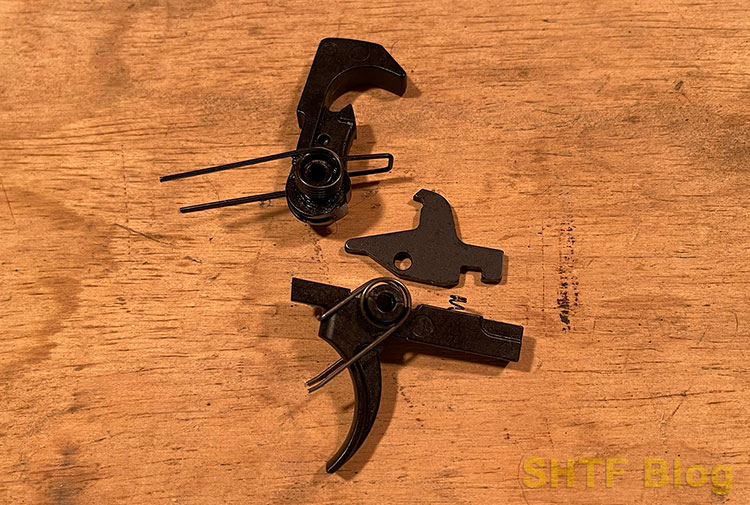
2) Drop the trigger into the receiver from the top, and fish it around the safety lever; I find that just getting the trigger protruding from its slot in the receiver and using it to wiggle it around helps immensely; usually keeping it level works best. As you get it located properly, push it down from the top against spring tension. Look through the trigger pin hole in the side of the receiver and get the trigger aligned to its proper location.
Start the trigger pin (the hammer and trigger pins are identical, BTW) in from one side, and push it through the side of the receiver, but not all the way through! Watch from the top, and when you see the pin start to move through the disconnector slot, back it off just a touch – we’re using the trigger pin to hold the trigger somewhat in place for the next step.
3) Drop the disconnector into the slot on the trigger, using the photo above as an orientation reference; note the notch in the disconnector sits over the coil spring you pushed into the top of the trigger. Push down on the disconnector, and once it’s aligned properly, lightly tap the trigger pin all the way through the trigger, disconnector, other side of the trigger, then receiver. If you are forcing it, it is certainly not aligned. Tip: use a punch inserted from the other side of the receiver to keep things aligned as you push the trigger pin through. Having the safety in the “off” position helps as well.
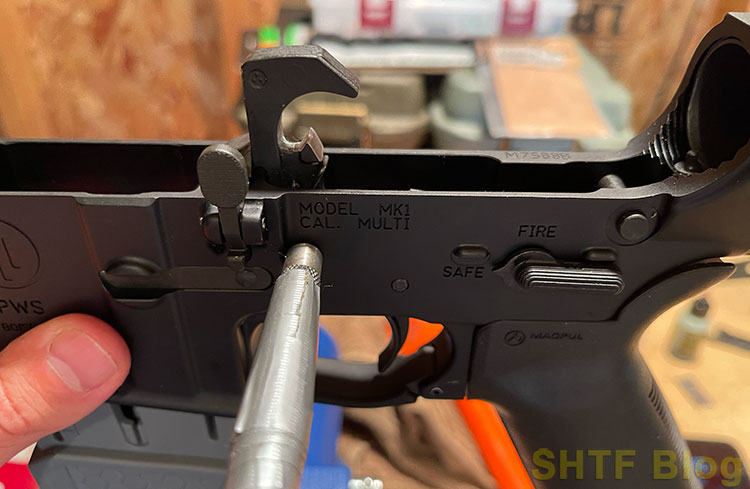
4) Insert the magazine release into the left side of the receiver, insert the magazine release spring on the opposite end around the threaded shaft of magazine release with a drop of oil.
5) Install the hammer. The two “legs” of the hammer spring need to be rotated backwards, to set on top of the trigger pin as you push the hammer towards. The two spring legs will rest on top of the trigger pin; one of the spring legs should sit in a small notch on the trigger pin; this helps keep the pin locked in place.
Keep pushing the hammer forward against the spring tension, until it is in the proper location at the front of the receiver. using a punch as a slave pin, keep the hammer in its proper location and push the hammer pin in from the opposite side, displacing the slave pin as you go. Once the pin is installed (again – don’t force it!) I’ll usually put a couple drops of oil on both the hammer and trigger pins to help assembly and ensure these high-use, high-friction points have adequate lubrication.
Drop-in Trigger Assembly
This is a more expensive, but easier and more effective system to install. A drop-in trigger set encapsulates the entire fire control group in one piece: the hammer, disconnector, trigger, and associated springs are all contained in one easy-to-install module.
To install a drop-in trigger, you’ll need the same hammer and trigger pins used in the Milspec trigger install above, but the other parts are not utilized. Simply drop the trigger module into the lower receiver in the cavity where the standard FCG would go, align the pin holes, and install the pins. That’s it. Go enjoy a beer.
Time for the Stock
In the case of the Magpul CTR stock like we have here, you need pull down the release latch to get it into place over the buffer tube. You might have to fight the release latch pin, but a mighty tug downwards will get the clearance necessary for you to slide the stock on over the buffer tube.
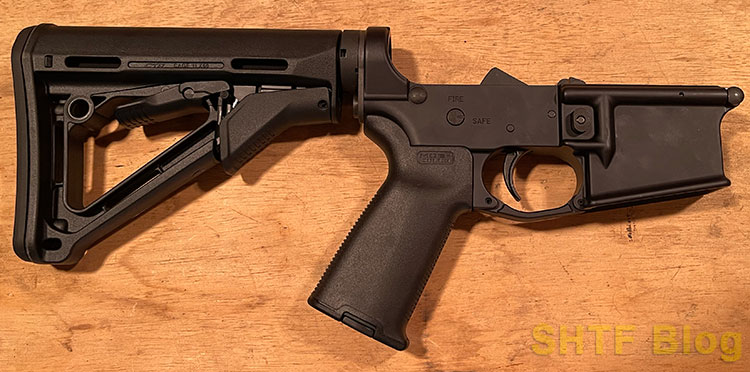
Staking the Castle Nut
An often overlooked but critical part of assembling your lower is staking the castle nut. It’s a simple process; simply take a hardened center punch, and use it to create a dimple on the edge of the backing plate, driving metal into the smaller notches on the castle nut. You don’t need to go too wild here; just moving a bit of metal will ensure the castle nut stays locked in place.
To remove the castle nut, a proper tool like the Magpul Armorer’s wrench will help you spin the castle nut off past the stakes if needed.

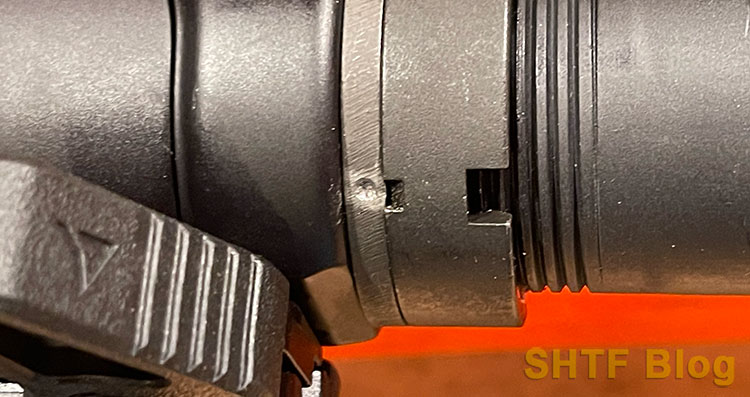
Accessories
Even with a great rifle platform, you still need a couple accessories to maximize the potential of the package. For a good all around rifle, you don’t need to go too nuts, though. Here’s what we’re adding to our PWI rifle built from Optics Planet orders.
Illumination
A good rifle needs a good light. While we’ve reviewed some rifle lights from Olight like the Odin shown on the bottom of the photo below, we’re going to be popping on a Streamlight Rail Mount 2 like the top unit in the photo. Streamlight’s customer service is without peer, and the quality and ruggedness of their products top notch. The Streamlight Protac Rail Mount 2 offers a well-sorted 625 lumens, a pressure switch, and a stout picatinny rail mounting system.
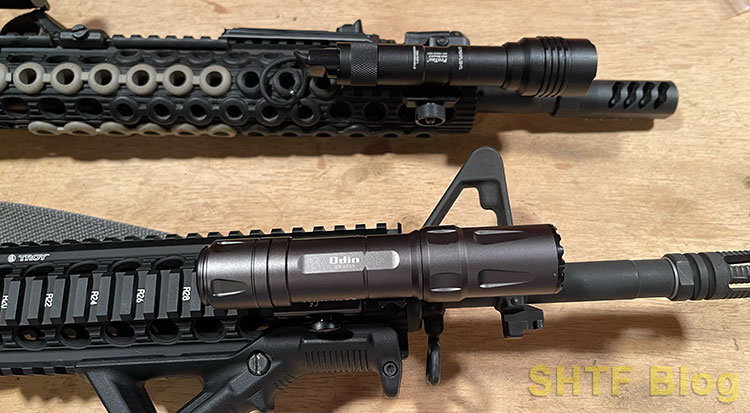
Sling
A well set up sling is an absolute must for a rifle that is designed for serious duty. Blue Force Gear’s Vickers sling strike the best balance we’ve found between wallet friendliness, quality, and dependability. Get you a couple push-button QD sling swivels and an MLOK QD port to mount on the handguard and you’re in business.
Sighting
You need to aim your rifle, right? Contrary to the sightless wonder ARs shown blasting baddies in “The Walking Dead”, we’d like an element of precision in our lives. So, we called upon a couple of the mightiest moguls in the sighting industry to help us hit what we’re aiming at: Magpul and Aimpoint.
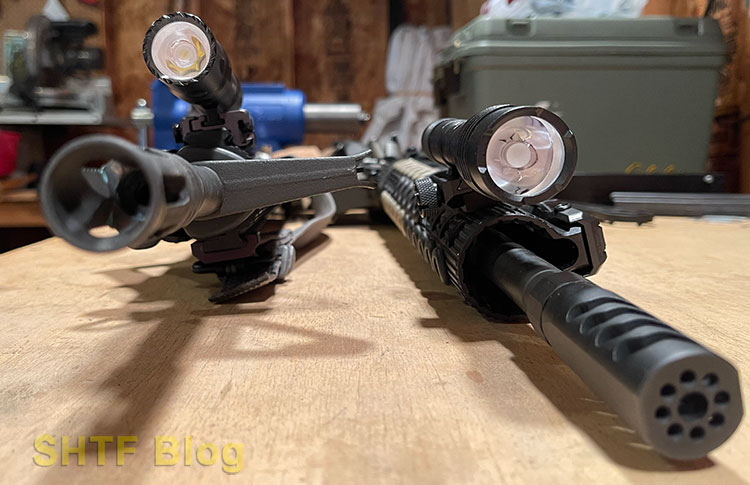
We sourced the excellent front and rear Magpul MBUS Pro folding sights as a backup to our primary sighting element, an Aimpoint PRO red dot. Though we also have an Eotec 512 holographic sight available, we chose the Aimpoint’s far superior battery life and smaller, more precise aiming dot for this rifle.
Summary
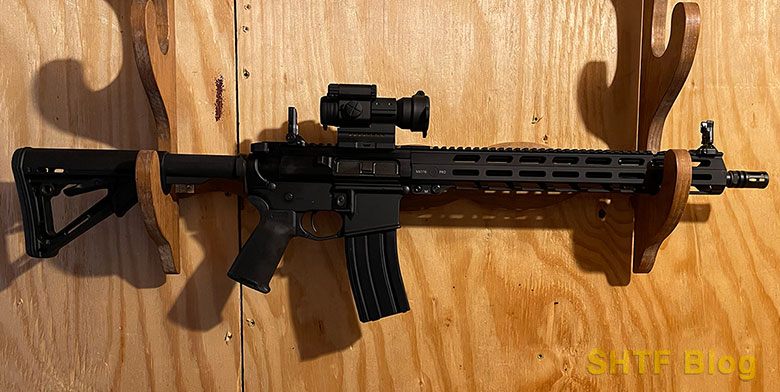
Building your own AR is incredibly rewarding; assembling a the functional rifle you wanted from a pile of parts in blister packs is reasonably easy and personally satisfying. There are myriad levels of performance available for almost literally EVERY PART on an AR-15; you can build the rifle on the cheap and upgrade as your budget allows – or you can throw down on bucks-up parts and build a dynamite rig sure to impress range buddies and post-apocalyptic zombies with equal aplomb. The end rifle shown here is somewhere in the middle of those extremes, but the money was spent where it counted to make the rifle a point of pride and utility for us.
If you haven’t built your own personal AR-15, what’s stopping you? If you budget allows, picking parts and rolling your own AR is the most wallet-friendly way to get a rifle specifically designed to accommodate your needs and perceived uses. So get out there, buy a good quality lower receiver, and start jamming parts on it; in today’s oversaturated AR market, there is literally no better time to buy than now and no better parts selection than from the folks at Optics Planet.
This AR turned out as a perfect manifestation of what I was looking for. There are many out there like it, but this one is mine!

1 comment
Nice build. I ended up building my first AR for financial reasons and the customization factor. I spent two years studying AR builds and parts, learning how to build one and developing an idea of what I wanted. I chose to stay close to mil-spec in the build but opted for upgraded parts on select items such as Nickel-Boron BCG, and a similarly coated and polished FCG. Not really having an idea of what muzzle device I wanted, I stuck with a 16″ barrel. At the time I built it the Wylde chamber was relatively unknown so I stayed with a 5.56 chamber, but would go with a Wylde on my next builds.
By planning to build my own, I could buy the parts as my budget permitted and take advantage of various sales, instead of having to come up with the complete cost in one go.
Many of the newer Lowers have some added features that make assembly much easier. The Bolt-catch roll-pin is being replaced by a screw in pin. The Safety detent hole is being threaded so a plug can be installed, preventing it from flying off if you need to remove your buffer tube.